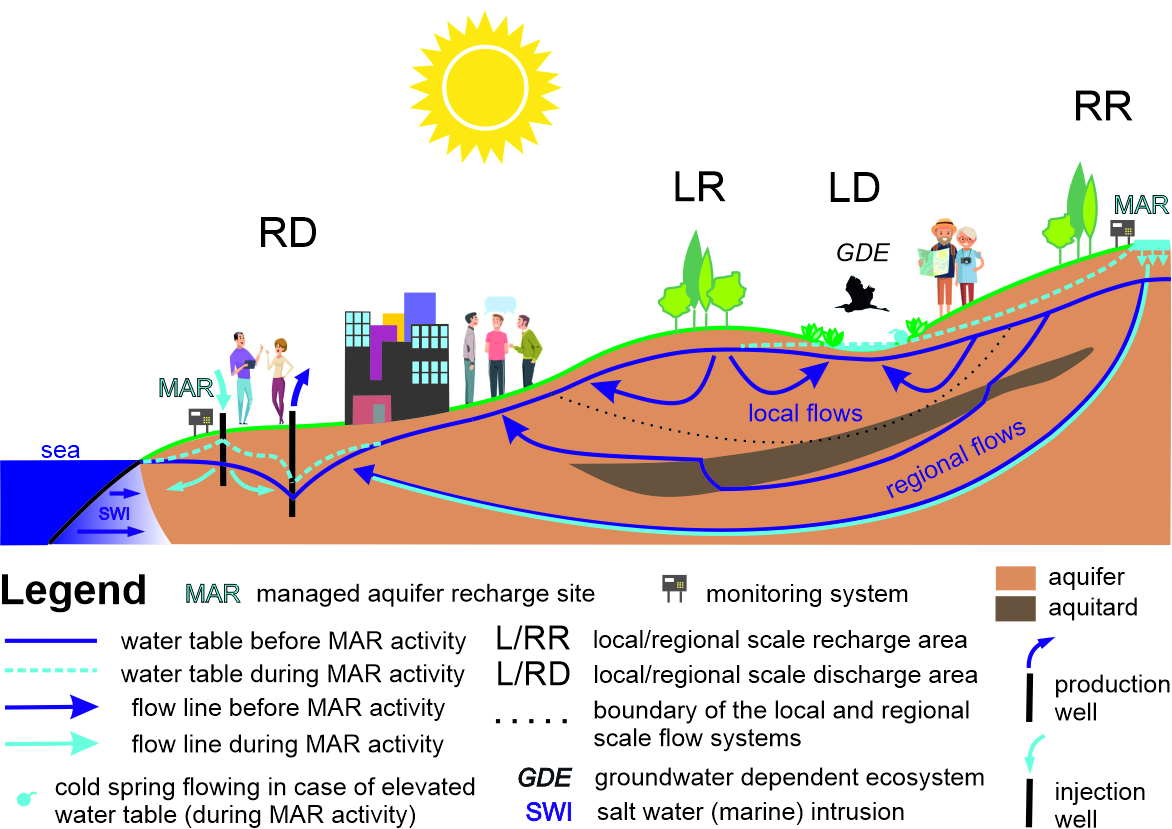About ClimEx-PE
Mitigating the impact of extreme hydrological events and ensuring a safe water supply for humanity and ecosystems is one of the most significant challenges of our time. The principal water reserves are in the aquifers, as groundwater. The connection of groundwater to surface water bodies and ecosystems makes these reserves vulnerable to extreme events, but they can also buffer the effects of hydrological extremities. However, general knowledge of groundwater is limited. The main goal of the ClimEx-PE project is to incorporate groundwater flow system evaluation, local scale MAR (Managed Aquifer Recharge) techniques, and co-creative public engagement, providing a new and upscaled nature-based MAR (NB-MAR) approach for regional scale mitigation of extreme hydroclimatic events.
The research intends to display:
- the influence of natural extremes on groundwater
- the application of NB-MAR to buffer climate events
- the impacts on groundwater quantity/quality
- the workflow for the involvement of the NB-MAR in society engagement, communication, education
- the consideration of groundwater flow systems and their replenishment with excess water in decision-making
- the integration of NB-MAR to water policies and develop a sustainable regulatory environment.
These goals can improve water management, resilience, and security and contribute to human rights. The project handles groundwater flow systems as the critical missing element of better water management. Different flow systems are naturally buffered against drought and flood. We propose using these natural differences through NB-MAR methods for water replenishment.
The project aims to have an impact on multidisciplinary fields.
(I) Natural scientific field: it produces datasets, models, and recommendations to disentangle
- trends of climate-hydrological extremes,
- their impact on groundwater bodies,
- the climate buffering role of groundwater flow systems and its better exploitation.
- Knowledge on the buffering capacity of aquifers is generated.
- Returning to society: a) monitoring tools for indicators; b) open access guides, events on the buffering capacity of groundwater flow and NB-MARs; c) a decision support tool.
(II) Socio-legal field: the project aims
- to elaborate materials that inform future NB-MAR projects to support the goals of local/regional sustainable water management;
- to develop guidelines by the cooperation of scientists, communication and educational experts using evidence-based assessment of efficiency;
- to produce a) stakeholder value propositions for NB-MAR solutions, b) briefing documents for policymakers with communication guidelines for NB-MAR solutions, c) digital, customizable communication packages;
- to create a method to integrate environmental, agricultural, industrial, and public service provision policies on water.
The proposal connects to Themes III, VII, V; Topics 1,2,3. Mostly, it connects to Theme III, addressing knowledge gaps by involving groundwater flow systems in understanding the connection between groundwater, surface water and extreme events, the management of water schemes and the recharge of aquifers (1.1). It develops an innovative understanding of how underground flow influences the quality/quantity of water processes (1.2). It proposes a nature-based water replenishment approach and intends to create a new methodology regarding groundwater's buffering role (2.2). It proposes a governance model (Theme VII) based on dashboard indicators to reduce vulnerability to extreme events (3.1), to reach more efficient citizen and stakeholder awareness and support the proposed strategy for mitigation and adaptation to hydroclimatic events (2.1). The dashboard can be applied to transboundary water resources and help with water diplomacy (1.3, 3.2). Regarding infrastructure (Theme V), the results help decision-makers reveal necessary adaptation steps to mitigate water infrastructure resilience.


